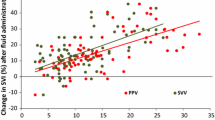Abstract
Background
The pleth variability index (PVI) is derived from analysis of the plethysmographic curve and is considered to be a noninvasive parameter for prediction of volume responsiveness. The aim of our prospective clinical study was to evaluate if volume responsiveness can be predicted by PVI in patients undergoing cardiac surgery after cardiopulmonary bypass.
Methods
Eighteen patients were prospectively studied. Directly after cardiac surgery, PVI, stroke volume variation (SVV), and cardiac index (CI) were recorded. Colloid infusion (4 ml/kg body weight) was used for volume loading, and volume responsiveness was defined as increase of CI more than 10 %.
Results
SVV and PVI measures were found to be highly correlated at r = 0.80 (p < 0.001). Receiver operating characteristics curve (ROC) analysis resulted in an area under the curve of 0.87 for SVV and 0.95 for PVI, which values did not differ statistically significant from each other (p > 0.05). The optimal threshold value given by ROC analysis was ≥11 % for SVV with a sensitivity and specificity of 100 % and 72.2 %. For PVI, optimal threshold value was ≥16 % with a sensitivity and specificity of 100 % and 88.9 %. Positive and negative predictive values estimating an increase of CI ≥10 % for SVV were 44.4 % and 100 % and 66.7 % and 100 % for PVI.
Conclusions
For consideration of fluid responsiveness PVI is as accurate as SVV in patients after cardiopulmonary bypass. Methodological limitations such as instable cardiac rhythm after cardiopulmonary bypass and right- or left ventricular impairment seem to be responsible for low specificity and positive predictive values in both parameters PVI and SVV.


Similar content being viewed by others
References
Michard F. Changes in arterial pressure during mechanical ventilation. Anesthesiology. 2005;103:419–28.
Marik PE, Baram M, Vahid B. Does central venous pressure predict fluid responsiveness? A systematic review of the literature and the tale of seven mares. Chest. 2008;134:172–8.
Osman D, Ridel C, Ray P, Monnet X, Anguel N, Richard C, Teboul JL. Cardiac filling pressures are not appropriate to predict hemodynamic response to volume challenge. Crit Care Med. 2007;35:64–8.
Zimmermann M, Feibicke T, Keyl C, Prasser C, Moritz S, Graf BM, Wiesenack C. Accuracy of stroke volume variation compared with pleth variability index to predict fluid responsiveness in mechanically ventilated patients undergoing major surgery. Eur J Anaesthesiol. 2010;27:555–61.
Loupec T, Nanadoumgar H, Frasca D, Petitpas F, Laksiri L, Baudouin D, Debaene B, Dahyot-Fizelier C, Mimoz O. Pleth variability index predicts fluid responsiveness in critically ill patients. Crit Care Med. 2011;39:294–9.
Renner J, Broch O, Gruenewald M, Scheewe J, Francksen H, Jung O, Steinfath M, Bein B. Non-invasive prediction of fluid responsiveness in infants using pleth variability index. Anaesthesia. 2011;66:582–9.
Cannesson M, Desebbe O, Rosamel P, Delannoy B, Robin J, Bastien O, Lehot JJ. Pleth variability index to monitor the respiratory variations in the pulse oximeter plethysmographic waveform amplitude and predict fluid responsiveness in the operating theatre. Br J Anaesth. 2008;101:200–6.
Forget P, Lois F, de Kock M. Goal-directed fluid management based on the pulse oximeter-derived pleth variability index reduces lactate levels and improves fluid management. Anesth Analg. 2010;111:910–4.
Pereira de Souza Neto E, Grousson S, Duflo F, Ducreux C, Joly H, Convert J, Mottolese C, Dailler F, Cannesson M. Predicting fluid responsiveness in mechanically ventilated children under general anaesthesia using dynamic parameters and transthoracic echocardiography. Br J Anaesth 2011;106:856–864.
Broch O, Bein B, Gruenewald M, Höcker J, Schöttler J, Meybohm P, Steinfath M, Renner J. Accuracy of the pleth variability index to predict fluid responsiveness depends on the perfusion index. Acta Anaesthesiol Scand. 2011;55:686–93.
Wajima Z, Shiga T, Imanaga K, Inoue T. Assessment of the effect of rapid crystalloid infusion on stroke volume variation and pleth variability index after a preoperative fast. J Clin Monit Comput. 2010;24:385–9.
DeLong ER, Delong DM, Clark-Pearson DL. Comparing the areas under two or more correlated receiver operating characteristic curves: a nonparametric approach. Biometrics. 1988;44:837–45.
Renner J, Scholz J, Bein B. Monitoring fluid therapy. Best Pract Res Clin Anaesthesiol. 2009;23:159–71.
Desgranges FP, Desebbe O, Ghazouani A, Gilbert K, Keller G, Chiari P, Robin J, Bastien O, Lehot JJ, Cannesson M. Influence of the site of measurement on the ability of plethysmographic variability index to predict fluid responsiveness. Br J Anaesth. 2011;107:329–35.
Cavallaro F, Sandroni C, Antonelli M. Functional hemodynamic monitoring and dynamic indices of fluid responsiveness. Minerva Anestesiol. 2008;74:123–35.
Cannesson M, Tran NP, Cho M, Hatib F, Michard F. Predicting fluid responsiveness with stroke volume variation despite multiple extrasystoles. Crit Care Med. 2012;40:193–8.
Mahjoub Y, Pila C, Friggeri A, Zogheib E, Lobjoie E, Tinturier F, Galy C, Slama M, Dupont H. Assessing fluid responsiveness in critically ill patients: false-positive pulse pressure variation is detected by Doppler echocardiographic evaluation of the right ventricle. Crit Care Med. 2009;37:2570–5.
Conflict of interest
Daniel A. Reuter is a member of the Medical Advisory Board of Pulsion Medical Systems. Apart from the conflict of interest mentioned above, all authors disclose (1) all funding sources, (2) any commercial or non-commercial affiliations, and (3) any other associations, such as consultancies. This study was funded solely by departmental sources.
Author information
Authors and Affiliations
Corresponding author
About this article
Cite this article
Haas, S., Trepte, C., Hinteregger, M. et al. Prediction of volume responsiveness using pleth variability index in patients undergoing cardiac surgery after cardiopulmonary bypass. J Anesth 26, 696–701 (2012). https://doi.org/10.1007/s00540-012-1410-x
Received:
Accepted:
Published:
Issue Date:
DOI: https://doi.org/10.1007/s00540-012-1410-x




